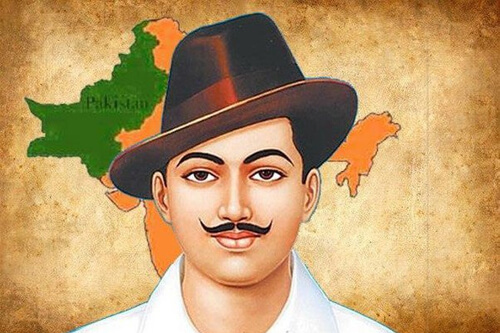BHAGAT SINGH

Bhagat Singh: A Beacon of Courage and Sacrifice in India's Struggle for Independence, Bhagat Singh, an iconic figure in the history of India's struggle for independence, remains a symbol of courage, sacrifice, and unwavering commitment to the ideals of freedom. Born on September 28, 1907, in Banga, Punjab (now in Pakistan), Bhagat Singh became a prominent revolutionary leader whose actions and ideology left an indelible mark on the collective conscience of the nation. This article explores the life, contributions, and legacy of Bhagat Singh, tracing his journey from a young patriot to an immortal hero.
Early Years and the Jallianwala Bagh Massacre:
Bhagat Singh's early years were marked by the influence of a politically charged environment. The Jallianwala Bagh massacre of 1919, where British forces killed hundreds of unarmed civilians in Amritsar, deeply impacted young Bhagat Singh. The gruesome incident fueled his resolve to fight against colonial oppression and injustice.
Involvement in the Freedom Movement:
Bhagat Singh was drawn to the ideals of Mahatma Gandhi and the non-cooperation movement initially. However, the Chauri Chaura incident of 1922, where a peaceful protest turned violent, led to the suspension of the non-cooperation movement. Bhagat Singh, disillusioned by the withdrawal of the movement, started exploring more radical avenues for achieving independence.
Hindustan Socialist Republican Association (HSRA):
In pursuit of a more aggressive approach, Bhagat Singh joined the Hindustan Socialist Republican Association (HSRA) in 1926. The HSRA aimed to achieve independence through revolutionary means and direct action. Bhagat Singh's association with like-minded revolutionaries, including Chandrashekhar Azad and Sukhdev, shaped his vision for a free and just India.
The Lala Lajpat Rai Incident:
One of the pivotal moments in Bhagat Singh's life was the death of Lala Lajpat Rai, a prominent leader, during a protest against the Simon Commission in 1928. In retaliation, Bhagat Singh and his comrades planned to seek justice by targeting the police official responsible for Lajpat Rai's death, James A. Scott. However, the plan went awry, and J.P. Saunders, a police officer, was mistakenly shot dead.
The Assembly Bombing and the Saunders' Killing:
In an audacious act of protest, Bhagat Singh and Batukeshwar Dutt threw non-lethal smoke bombs in the Central Legislative Assembly in Delhi on April 8, 1929. The purpose was to protest against repressive laws, and they willingly courted arrest. During the trial, Bhagat Singh refused to plead for mercy and, along with Rajguru and Sukhdev, was sentenced to death for the killing of J.P. Saunders.
Imprisonment and Hunger Strike:
Bhagat Singh's time in prison was marked by his commitment to the cause of independence. While incarcerated in Lahore Central Jail, he went on a hunger strike to protest against the inhumane treatment of political prisoners. The hunger strike, which lasted for 116 days, brought international attention to the plight of Indian political prisoners.
Legacy of Bhagat Singh:
Ideological Legacy:
Bhagat Singh's writings, including his prison diaries, articles, and letters, reflect his deep understanding of socio-political issues. His ideological legacy continues to inspire generations of Indians to question injustice, oppression, and inequality.
Commitment to Secularism:
Bhagat Singh was a staunch advocate of secularism, emphasizing that the struggle for independence transcended religious boundaries. His commitment to unity and inclusivity remains relevant in contemporary times.
Emphasis on Education:
Bhagat Singh stressed the importance of education in creating an informed and enlightened society. He believed that true freedom could only be achieved when individuals were intellectually and morally awakened.
Martyrdom and Nationalism:
Bhagat Singh's martyrdom elevated him to the status of a national hero. His sacrifice for the country became a rallying point for nationalists, motivating them to continue the struggle for independence.
Legacy in Popular Culture:
Bhagat Singh's life has been portrayed in numerous books, movies, and songs. His persona continues to captivate artists and filmmakers, ensuring that his story remains a part of popular culture.
Conclusion:
Bhagat Singh's life was tragically cut short on March 23, 1931, when he was hanged by the British authorities at the age of 23. His sacrifice, however, ignited a flame of resistance that burned bright in the hearts of countless Indians. Bhagat Singh's legacy extends beyond his physical presence, living on as an enduring symbol of fearlessness, determination, and the indomitable spirit of a young nation aspiring for freedom. His words, "Inquilab Zindabad" (Long Live the Revolution), continue to echo in the corridors of Indian history, reminding us of the price paid for the liberty we enjoy today.
Article written by:
Yashika
(Yellow Belt Holder, TMAA, Delhi)
